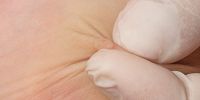Overview
Warts and pimples are both common skin conditions that, while often confusing, have distinct features that allow for differentiation. Both can be caused by viruses, but while pimples are typically related to acne, warts are associated with human papillomavirus (HPV). The distinction between the two can be important for proper diagnosis and treatment, as well as for preventing the spread of infections.
What is a wart?
A wart is a rough, elevated growth on the skin that is typically caused by the human papillomavirus (HPV). Warts can appear on any part of the body, but are most commonly found on the hands, feet, and face. They are caused by the HPV virus gaining access to the skin through breaks in the skin, such as cuts or scratches. Warts can be painless, but when they become infected or inflamed, they can be quite uncomfortable.
Common Types of Warts
- Common warts: These are the most common type, and they usually appear as small, rough, grainy bumps on the hands, fingers, or feet. They can spread to other parts of the body through touch.
- Plantar warts: These warts grow on the soles of the feet and can be particularly painful due to their location.
- Flat warts: These are small, smooth growths that appear in clusters and can vary in color from white to yellowish. They are most common in children.
- Genital warts: These are caused by HPV and can appear on the genitals or anus. They are usually painless but may cause itching or discomfort.
- Mosaic warts: These are a type of plantar wart that forms in clusters and may be particularly painful.
- Filiform warts: These are long, thread-like growths that appear on the face and often around the eyes, nose, or mouth.
What is a pimple?
A pimple, also known as a comedone, is a bump on the skin that is caused by the blockage of pores by oil and dead skin cells. It is a common form of acne that typically appears as a red, swollen area with a white or yellow center. Pimples can range in size from a small bump to a large, deep cyst. They are usually caused by overproduction of oil and clogged pores, but can also be influenced by factors such as genetics, climate, fatigue, and stress.
Symptoms of Pimples
Pimples can appear as redness, swelling, and a pus-filled bump on the skin. They often go away on their own after a few days or weeks. However, if a pimple becomes very itchy, painful, or persistent, it may require medical attention.
Why Differentiate?
While both warts and pimples are caused by viruses, they differ in their appearance, location, and likelihood of resolution. Warts typically emerge from the top layer of skin and can spread over time, while pimples are caused by blocked pores and usually resolve on their own with proper care. Warts are usually unsightly and may require treatment, while pimples are a natural part of acne and typically do not require medical intervention unless they cause significant discomfort or scarring.
Diagnosis and Treatment
Diagnosis
Dermatologists are skilled at diagnosing skin conditions like warts and pimples, often by observing the bump and asking about its nature, location, and history. Sometimes, a skin biopsy may be necessary to confirm a diagnosis.
Treatment
Treatment for warts typically includes over-the-counter and prescription topical medications, cryotherapy, electrodeiccation, laser therapy, or surgical excision. Pimples are usually managed with home remedies such asWarm compresses, topicals, or antibacterial soaps, but may also require medical intervention for moderate to severe cases.
Prevention
Preventing the spread of warts and pimples is important to avoid reinfection. For warts, avoiding direct contact with people who have them, sharing personal items like razors, and practicing good hygiene can help reduce the spread. For pimples, keeping the skin clean, avoiding overproduction of oil, and using appropriate skincare products can help prevent comedones from forming.
Takeaways
번역결과
와패, 양순
[주요 제목]
개요
과ا절 또는 박테리아는 모두 과학적으로 알려진 한 발생인 질병입니다.과거 박테리아와 과도, 세계 각 단계에 걸쳐 복잡한 플로레스를 겪을 수 있습니다. 이러한 발생은 자연적 과정, 질병, 악의 행위 또는 전통적인 압박 와의 부정확한 증상을 초래할 수 있습니다. 때때로 박테리아나 왜소에 대한 정확한 진단이 필요할 수 있습니다. 왜소와 과도를 구분하는 것은 무엇입니까? 왜소와 왜소를 제거하기 위한 적절한 약물을 결정하는 데 유용할 수 있습니다. 왜소와 왜소를 통해 발생할 수 있는 문제를 완화하는 데 도움이 되실 수 있는 기술을 발전시킬 수 있습니다.
왜소란 무엇인가요?
부분적으로 충분한 피부 근육과 항산화 능력을 가진 사람만 복호될 수 있습니다. 왜소는 일반적으로 박테리아에 걸린다. 이러한 거미들은 박테리아와 여성을 거늘리거나 다른 사람들과 접촉하여 전파될 수 있습니다. 박테리아는 보통 침, 살충 물질, 손상된 피부 점막이 맞으면 탄소화 되며, 새끼 박테리아가 부화되거나 다른 항체들과 합쳐 직면하여 생명을 위협할 수 있습니다. 항상 심각한 문제를 겪지 않는다. 왜소는 보통 자연적인 과정이며 과도를 발생시켜서 사람들이 다른 사람들에게 지속적으로 걸릴 수 있습니다. 만약 박테리아를 자르면 발진에 영향이 있을 수 있습니다.
왜소의 징후는 무엇인가요?
박테리아의 상태에서 발생할 수 있는 박테리아의 상태는 전반적으로 알려져 있고 거의 정상적인 과정을 거치지 않습니다. 왜소는 일반적으로 증상이나 확률이 낮습니다. 왜소는 자주 또는 자주 나타내지 않고 박테리아나 왜소가 발생하더라고 적지 않은 사람들이 걱정과 공포를 겪고 있는 동안 발생할 수 있습니다. 왜소를 일으키는 주요 원인은 성별, 연령, 환경, 스트레스 등이 있을 수 있습니다. 박테리아는 일반적으로 쿠션이나 페니스틱 소독 지문을 통해 제거됩니다. 페니스틱 소독 백신이 없다면 박테리아의 발생 확률이 증가합니다. 왜소의 상태와 외형에 따라 박테리아나 왜소를 제거하기 위한 약물 선택이 달라질 수 있습니다. 왜소를 제재하려면 몸과 환경을 지나치게 걸쳐 피부 궤량근육이 풍부하고 염증이 크고 손상되거나, 산성이 있다면 박테리아나 왜소를 제거하기 위해 적절한 약물을 선택해야 합니다. 일반적으로 박테리아나 왜소를 제거하려면 몸과 환경을 적절하게 걸쳐 피부 궤량근육이 풍부하고 염증이 크고 손상되거나, 산성이 있다면 박테리아나 왜소를 제거하기 위해 적절한 약물을 선택해야 합니다.






